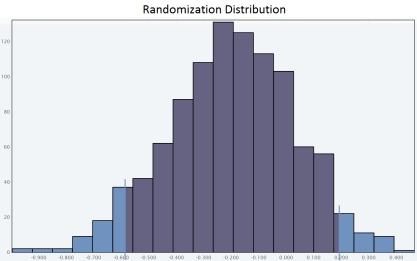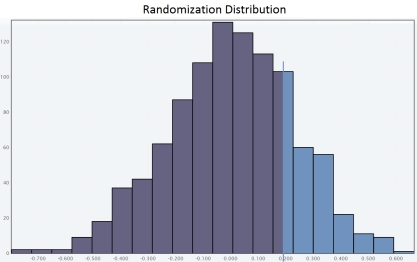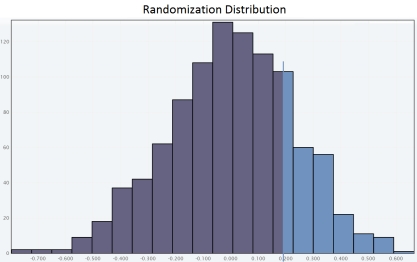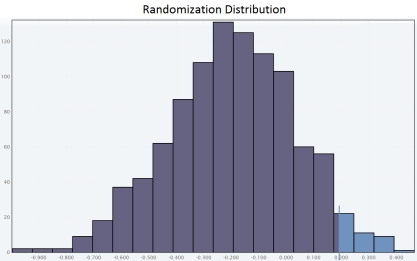The researchers suggested that the time of the second race in karting is less than during the first race because a person remembers the track. Suppose 8 adults were randomly selected. The time spent on the first and second race was recorded for each person from the sample and resulting data are given in the accompanying table.  Do these data support the claim that the mean difference in time spent on the first and second race is greater than zero? Use a randomization test to select the appropriate output for one set of 1000 simulated sample differences in means and carry out a hypothesis test for a difference in means.
Do these data support the claim that the mean difference in time spent on the first and second race is greater than zero? Use a randomization test to select the appropriate output for one set of 1000 simulated sample differences in means and carry out a hypothesis test for a difference in means.
A) 
 Since the approximate P-value is greater than
Since the approximate P-value is greater than  , we reject H0 for a significance level of 0.05.So the sample provides convincing evidence that the mean difference in time spent on the first and second race is greater than zero.
, we reject H0 for a significance level of 0.05.So the sample provides convincing evidence that the mean difference in time spent on the first and second race is greater than zero.
B) 
 Since the approximate P-value is greater than
Since the approximate P-value is greater than  , we reject H0 for a significance level of 0.05.So the sample provides convincing evidence that the mean difference in time spent on the first and second race is greater than zero.
, we reject H0 for a significance level of 0.05.So the sample provides convincing evidence that the mean difference in time spent on the first and second race is greater than zero.
C) 

Since the approximate P-value is greater than  , we fail to reject H0 for a significance level of 0.05.So the sample does not provide convincing evidence that the mean difference in time spent on the first and second race is greater than zero.
, we fail to reject H0 for a significance level of 0.05.So the sample does not provide convincing evidence that the mean difference in time spent on the first and second race is greater than zero.
D) 

Since the approximate P-value is greater than  , we fail to reject H0 for a significance level of 0.05.So the sample does not provide convincing evidence that the mean difference in time spent on the first and second race is greater than zero.
, we fail to reject H0 for a significance level of 0.05.So the sample does not provide convincing evidence that the mean difference in time spent on the first and second race is greater than zero.
E) 

Since the approximate P-value is less than  , we reject H0 for a significance level of 0.05.So the sample provides convincing evidence that the mean difference in time spent on the first and second race is greater than zero.
, we reject H0 for a significance level of 0.05.So the sample provides convincing evidence that the mean difference in time spent on the first and second race is greater than zero.
Correct Answer:
Verified
Q29: Suppose 9 adult smokers were randomly selected.
Q30: Suppose 8 adult patients with the same
Q31: When estimating the difference between two treatment
Q32: When a surgeon repairs injuries, sutures (stitched
Q33: The Iowa Tests of Basic Skills is
Q35: A common memory task is the classification
Q36: Viruses are infectious agents that often cause
Q37: An article describes a study of the
Q38: Body fat and lean body mass can
Q39: The perception of danger is an important
Unlock this Answer For Free Now!
View this answer and more for free by performing one of the following actions

Scan the QR code to install the App and get 2 free unlocks

Unlock quizzes for free by uploading documents